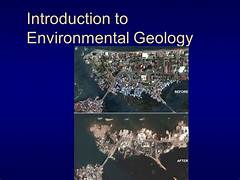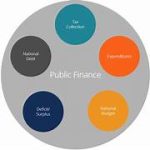Evaluating the Fundamental Concepts of Environmental Geology
Introduction
Environmental geology is a crucial field of study that examines the interaction between human activities and the Earth’s geological systems. It helps in understanding natural hazards, resource management, and environmental sustainability. With increasing concerns about climate change, pollution, and land degradation, environmental geology has become essential for making informed decisions about land use, conservation, and disaster management.
This article evaluates the fundamental concepts of environmental geology, including earth materials, geologic processes, natural hazards, resource management, and environmental protection.
1. Earth Materials and Their Importance
Understanding earth materials—rocks, minerals, and soils—is fundamental to environmental geology. These materials form the foundation of our planet and directly impact construction, agriculture, and water quality.
a) Types of Rocks and Their Role in the Environment
Rocks are classified into three major types:
- Igneous Rocks – Formed from cooled lava or magma (e.g., granite, basalt). Used in construction and road building.
- Sedimentary Rocks – Created from compacted sediments (e.g., limestone, sandstone). Often contain fossils and groundwater reservoirs.
- Metamorphic Rocks – Formed under heat and pressure (e.g., marble, slate). Used in construction and decoration.
The type of rock present in an area affects soil fertility, water infiltration, and the stability of infrastructure.
b) Minerals and Their Environmental Significance
Minerals are natural compounds that make up rocks. Some, like quartz and feldspar, are abundant, while others, like rare earth elements, are critical for technology. However, mining these minerals can lead to environmental issues like land degradation, water pollution, and deforestation.
c) Soil Composition and Its Role in Ecosystems
Soil is a mix of minerals, organic matter, water, and air. It plays a key role in:
- Agriculture (supporting plant growth).
- Water filtration (preventing groundwater contamination).
- Carbon storage (helping in climate regulation).
Poor soil management can lead to erosion, desertification, and reduced agricultural productivity.
2. Geological Processes and Environmental Impacts
The Earth’s surface is constantly changing due to geological processes such as erosion, weathering, plate tectonics, and sedimentation. These processes shape landscapes, influence climate, and affect ecosystems.
a) Plate Tectonics and Earth’s Structure
The theory of plate tectonics explains how the Earth’s outer shell is divided into large plates that move over the mantle. These movements cause:
- Earthquakes – Result from the movement of tectonic plates.
- Volcanic Activity – Occurs at plate boundaries, releasing gases and affecting climate.
- Mountain Formation – Created by colliding plates, impacting weather patterns and biodiversity.
Understanding plate tectonics helps geologists predict natural disasters and assess geologic hazards.
b) Weathering and Erosion
- Weathering is the breakdown of rocks due to temperature, water, and biological activity.
- Erosion is the movement of weathered materials by wind, water, or ice.
Human activities, like deforestation and construction, accelerate erosion, leading to sedimentation in rivers, loss of fertile soil, and increased flood risks.
c) Groundwater and Hydrogeology
Water is stored underground in aquifers, which provide drinking water to millions. However, over-extraction and pollution from industrial and agricultural activities threaten water security.
Sustainable groundwater management ensures:
- Safe drinking water supplies.
- Protection of wetlands and aquatic ecosystems.
- Prevention of land subsidence caused by excessive groundwater withdrawal.
3. Natural Hazards and Disaster Management
Environmental geology helps assess and mitigate risks from natural disasters such as earthquakes, landslides, floods, and volcanic eruptions.
a) Earthquakes and Seismic Risks
Regions near tectonic plate boundaries experience frequent earthquakes. Modern engineering and urban planning use seismic hazard maps to construct earthquake-resistant buildings and infrastructure.
b) Landslides and Slope Stability
Landslides occur when soil and rock move downhill due to gravity, often triggered by heavy rainfall, deforestation, or construction. Preventive measures include:
- Slope reinforcement.
- Reforestation.
- Controlled drainage systems to prevent water accumulation.
c) Floods and River Management
Floods occur when excessive rainfall overwhelms riverbanks or urban drainage systems. Climate change has intensified flooding events, making effective floodplain management crucial. Strategies include:
- Constructing levees and dams.
- Maintaining natural wetlands as flood buffers.
- Developing urban drainage systems to control runoff.
d) Volcanic Eruptions and Environmental Impact
Volcanic activity can have long-term environmental consequences, such as:
- Air pollution from ash and gas emissions.
- Displacement of communities due to lava flows.
- Climate effects from sulfur dioxide emissions, which can cool global temperatures.
Monitoring volcanic activity with remote sensing and seismic data helps reduce disaster risks.
4. Resource Management and Environmental Sustainability
Sustainable management of natural resources like minerals, forests, water, and fossil fuels is essential for long-term environmental and economic stability.
a) Fossil Fuels vs. Renewable Energy
- Fossil Fuels (Coal, Oil, Natural Gas) – Major energy sources but contribute to air pollution and climate change.
- Renewable Energy (Solar, Wind, Hydropower, Geothermal) – Reduces reliance on fossil fuels and lowers carbon emissions.
Transitioning to renewable energy helps mitigate environmental degradation and promotes sustainability.
b) Mining and Environmental Degradation
Mining provides essential materials for industries but has serious environmental impacts:
- Land degradation and deforestation.
- Water pollution from toxic runoff.
- Loss of biodiversity in mining regions.
Sustainable mining practices include:
- Recycling metals to reduce the need for new mining.
- Enforcing environmental regulations on waste disposal.
- Land rehabilitation and reforestation in mined areas.
c) Water Resource Management
Water is a limited resource, and mismanagement leads to scarcity and pollution. Effective water management strategies include:
- Rainwater harvesting and conservation.
- Reducing industrial water consumption.
- Preventing contamination from agricultural runoff and industrial waste.
5. Environmental Protection and Climate Change Mitigation
Climate change, pollution, and deforestation are major global challenges that require geological expertise for sustainable solutions.
a) Climate Change and Carbon Sequestration
Geological studies help in understanding climate patterns and carbon storage solutions. Carbon sequestration techniques, such as underground storage of CO₂, can reduce greenhouse gas emissions.
b) Pollution Control and Waste Management
Environmental geology plays a role in managing waste and pollution:
- Air Pollution – Caused by industrial emissions and deforestation. Geologists help in monitoring air quality and recommending mitigation strategies.
- Soil Pollution – Heavy metals and chemicals from factories and agriculture contaminate soil, affecting food production.
- Water Pollution – Contaminants from industrial runoff and oil spills threaten aquatic ecosystems. Geologists develop methods to filter and clean contaminated water.
c) Conservation of Natural Habitats
Protecting natural landscapes, forests, and wetlands ensures biodiversity and ecological balance. Geologists help in:
- Identifying protected areas that require conservation.
- Assessing environmental impact before construction projects.
- Restoring ecosystems affected by human activities.
Conclusion
Environmental geology is a multidisciplinary field that integrates earth sciences with environmental management to address critical global challenges. Understanding earth materials, geological processes, natural hazards, and sustainable resource management helps in making informed decisions to protect the environment and human societies.
As human activities continue to shape the planet, environmental geologists play a crucial role in ensuring that economic development does not come at the expense of environmental sustainability. Future advancements in technology and research will further enhance our ability to manage natural resources, mitigate disasters, and combat climate change effectively.
By applying fundamental principles of environmental geology, governments, businesses, and individuals can work together to create a more sustainable and resilient world.


